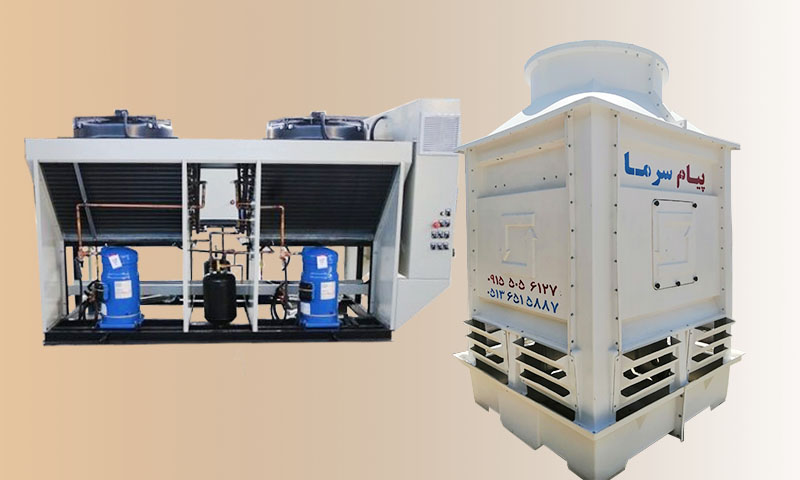Cooling towers and chillers are two very widely used refrigeration systems in the industry. The main task of these two systems is to cool the liquid used in work cycles. In general, it can be said that cooling towers and chillers have a similar purpose and sometimes have similar functions, but these two devices definitely have major differences. Read more about the difference between cooling towers and chillers.
First, let’s get acquainted with the definition of these two industrial devices in brief…
Chiller definition
A chiller is a device that lowers the water temperature based on the condensation or absorption refrigeration cycle.
Definition of cooling tower
A cooling tower is a device that lowers the temperature of water based on contact between water and air and evaporation of water.

The difference between cooling towers and chillers
- The amount of water temperature reduction: the main and most important difference between cooling towers and chillers is the amount of water or fluid temperature reduction. In general, it can be said that cooling towers can only lower the temperature of the water to close to the temperature of the moist ambient air. For example, in a city like Tehran, where the wet temperature is about 23 degrees Celsius, the temperature of the water leaving the cooling tower is 26 degrees Celsius. In general, experts say that cooling towers should not expect a drop of more than 8 degrees Celsius. The important thing is that the water entering the device should not be too hot. The temperature of the incoming hot water should be such that it does not damage the packings.
But the situation is different in chillers. Depending on the type of design, chillers can reduce the water temperature even below 10 degrees Celsius. Therefore, in the hot seasons of the year, cooling towers do not work very well.
- Application in industries: Due to the difference in cooling rate, cooling towers and chillers are used in various industries. Cooling towers are often used in large industries such as refineries, power plants, and large factories that do not need very low temperature water.
Chillers are also used in industries such as soap making, plastics, etc., which require very low temperature water in their cycle.
- Energy consumption: In general and in summary, it can be said that chillers consume more energy than cooling towers. Cooling towers have a number of pumps, fans, and motors to circulate the power source and water, all of which require energy consumption; But in contrast to the energy consumption of the compressor, condenser and heat exchangers in the chillers, they consume less energy.
- Price: With a quick review, you can see that the price of the cooling tower is much lower than the chiller. The price range of cooling towers is from 20 million tomans to 150 million tomans. This is despite the fact that the price range of chillers starts from around 50 million Tomans and sometimes reaches more than 1 billion Tomans.
- Repairs: In terms of repairs, repairing cooling towers is much easier than repairing chillers.
Now the question that arises is whether these two devices are only used separately? Can a combination of cooling towers and chillers be used?
In response to these questions, it should be said that in certain circumstances, the combination of these two devices can be used together. The name of this combined device is “cooling tower chiller”, which we provide a brief explanation of below.
What is a cooling tower chiller?
If we want to express the definition of this device in a very simple way, we must say that; The cooling tower of the chiller is a device that is responsible for removing the heat from the condenser of the chiller. As you know, in chillers, the refrigerant increases in temperature and pressure in the compression or absorption cycle. Then the hot refrigerant enters the condenser and its temperature is taken by the water inside the condenser. Now the temperature of the heated water in the condenser is rejected by the cooling tower.
The remarkable and important point about the chiller cooling tower is that not every chiller can be used in this combination. Rather, only chillers with water condenser and water cycle systems, or so-called cold water chillers, have this capability.

